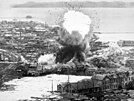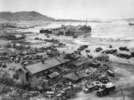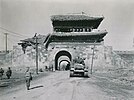 Global Information
Global InformationKorean War information
This article may be too long to read and navigate comfortably. When this tag was added, its readable prose size was 16,000 words. (June 2023) |
| Korean War | |||||||||
|---|---|---|---|---|---|---|---|---|---|
| Part of the Cold War and the Korean conflict | |||||||||
     Clockwise from top:
| |||||||||
| |||||||||
| Belligerents | |||||||||
|
|
| ||||||||
Medical support:[5]
Other support:
|
Supported by:
| ||||||||
| Commanders and leaders | |||||||||
|
| ||||||||
|
| ||||||||
| Strength | |||||||||
|
Peak strength (combat troops):
Total strength[26][27] (combat troops):
|
Peak strength
Total:(combat troops):
Together: 1,742,000 Together: 3,042,000 | ||||||||
| Casualties and losses | |||||||||
| |||||||||
The Korean War was fought between North Korea and South Korea from 1950 to 1953. It began on 25 June 1950 when North Korea invaded South Korea and ceased after an armistice on 27 July 1953. The north was supported by China and the Soviet Union while the south was supported by United Nations (UN) forces[c] led by the United States.
When World War II ended in 1945, Korea, which had been a Japanese colony for 35 years, was temporarily divided by the United States and the Soviet Union along the 38th parallel.[d] Due to Cold War tensions, however, each half became a sovereign state. North Korea was led by Kim Il Sung, and South Korea was led by Syngman Rhee. Both claimed to be the sole legitimate government of all of Korea and neither accepted the 38th parallel as permanent.
The two sides were engaged in border skirmishes, while the South also suppressed an uprising in Jeju (April 1948 - May 1949) abetted by Pyongyang.[35][36][37] On 25 June 1950, the north's Korean People's Army (KPA) invaded below the 38th parallel.[38][39] In the absence of the Soviet Union,[c] the United Nations Security Council denounced the attack and recommended countries to repel the KPA under the United Nations Command.[41] UN forces would eventually include twenty-one countries, with the United States providing around 90% of the military personnel.[42][43]
After the first two months of war, the South Korean army (ROKA) and its allies were nearly defeated, holding onto only the Pusan Perimeter. In September 1950, however, UN forces landed at Incheon, cutting off KPA troops and supply lines. They invaded North Korea in October 1950 and advanced towards the Yalu River—the border with China. On 19 October 1950, the Chinese People's Volunteer Army (PVA) crossed the Yalu and entered the war.[38] UN forces retreated from North Korea following PVA's first and second offensive. Communist forces captured Seoul again in January 1951 before losing it. Following the abortive Chinese spring offensive, they were pushed back to the 38th parallel, and the final two years turned into a war of attrition.
The combat ended on 27 July 1953 when the Korean Armistice Agreement was signed, allowing the exchange of prisoners and the creation of the Korean Demilitarized Zone (DMZ). The conflict displaced milions of people, inflicted around 3 million fatalities and a larger proportion of civilian deaths than World War II or the Vietnam War. Alleged war crimes include the killing of suspected communists by the South Korean government and the torture and starvation of prisoners of war by the North Koreans.[citation needed] North Korea became one of the most heavily bombed countries in history.[44] Virtually all of Korea's major cities were destroyed.[45] No peace treaty was ever signed, making this a frozen conflict.[46][47]
- ^ Kim, Heesu (1996). Anglo-American Relations and the Attempts to Settle the Korean Question 1953–1960 (PDF) (Thesis). London School of Economics and Political Science. p. 213. Archived (PDF) from the original on 10 April 2017. Retrieved 9 April 2017.
- ^ "Italian Red Cross Hospital". Archived from the original on 22 August 2012. Retrieved 2 June 2012.
- ^ "6.25전쟁 당시 대한민국에 도움의 손길 내밀었던 이탈리아". Newsis. 26 August 2016. Archived from the original on 7 July 2023. Retrieved 12 April 2021.
- ^ "독일, 62년만에 6.25 전쟁 의료지원국에 포함…총 6개국으로 늘어". 헤럴드경제. 22 June 2018. Retrieved 4 April 2021.
- ^ 임, 성호 (19 June 2020). "[6.25전쟁 70년] 이역만리 한국서 수백만명 살리고 의술 전파까지". Yeonhap News. Retrieved 4 April 2021.
- ^ Young, Sam Ma (2010). "Israel's Role in the UN during the Korean War" (PDF). Israel Journal of Foreign Affairs. 4 (3): 81–89. doi:10.1080/23739770.2010.11446616. S2CID 219293462. Archived from the original (PDF) on 24 August 2015.
- ^ a b Morris-Suzuki, Tessa (29 July 2012). "Post-War Warriors: Japanese Combatants in the Korean War". The Asia-Pacific Journal: Japan Focus. 10 (31).
- ^ Whan-woo, Yi (16 September 2019). "Pakistan's Defense Day rekindles Korean War relief aid". The Korea Times. Archived from the original on 27 November 2020. Retrieved 2 May 2020.
- ^ "Uruguay's little-known but important role in the Korean War". Korea.net. 10 February 2022. Retrieved 4 September 2022.
- ^ Edles, Laura Desfor (1998). Symbol and Ritual in the New Spain: the transition to democracy after Franco. Cambridge, UK: Cambridge University Press. p. 32. ISBN 978-0521628853.
- ^ Cite error: The named reference
rozhlas czwas invoked but never defined (see the help page). - ^ a b Edwards, Paul M. (2006). Korean War Almanac. Almanacs of American wars. New York: Infobase Publishing. p. 528. ISBN 978-0816074679. Archived from the original on 4 July 2017.
- ^ Kocsis, Piroska (2005). "Magyar orvosok Koreában (1950–1957)" [Hungarian physicians in Korea (1950–1957)]. ArchivNet: XX. századi történeti források (in Hungarian). Budapest: Magyar Országos Levéltár. Archived from the original on 10 May 2017. Retrieved 22 November 2016.
- ^ "Romania's "Fraternal Support" to North Korea during the Korean War, 1950–1953". Wilson Centre. December 2011. Archived from the original on 21 February 2013. Retrieved 24 January 2013.
- ^ Birtle, Andrew J. (2000). The Korean War: Years of Stalemate. U.S. Army Center of Military History. p. 34. Retrieved 21 August 2021.
- ^ Millett, Allan Reed, ed. (2001). The Korean War, Volume 3. Korea Institute of Military History. U of Nebraska Press. p. 692. ISBN 978-0803277960. Retrieved 16 February 2013.
Total Strength 602,902 troops
- ^ Kane, Tim (27 October 2004). "Global U.S. Troop Deployment, 1950–2003". Reports. The Heritage Foundation. Archived from the original on 28 January 2013. Retrieved 15 February 2013.
Ashley Rowland (22 October 2008). "U.S. to keep troop levels the same in South Korea". Stars and Stripes. Archived from the original on 12 May 2013. Retrieved 16 February 2013.
Colonel Tommy R. Mize, United States Army (12 March 2012). "U.S. Troops Stationed in South Korea, Anachronistic?" (PDF). United States Army War College. Defense Technical Information Center. Archived from the original on 8 April 2013. Retrieved 16 February 2013.
Louis H. Zanardi; Barbara A. Schmitt; Peter Konjevich; M. Elizabeth Guran; Susan E. Cohen; Judith A. McCloskey (August 1991). "Military Presence: U.S. Personnel in the Pacific Theater" (PDF). Reports to Congressional Requesters. United States General Accounting Office. Archived from the original (PDF) on 15 June 2013. Retrieved 15 February 2013. - ^ a b c d e f g USFK Public Affairs Office. "USFK United Nations Command". United States Forces Korea. United States Department of Defense. Archived from the original on 11 July 2016. Retrieved 29 July 2016.
Republic of Korea – 590,911
Colombia – 1,068
United States – 302,483
Belgium – 900
United Kingdom – 14,198
South Africa – 826
Canada – 6,146
Netherlands – 819
Turkey – 5,453
Luxembourg – 44
Australia – 2,282
Philippines – 1,496
New Zealand – 1,385
Thailand – 1,204[clarification needed]
Ethiopia – 1,271
Greece – 1,263
France – 1,119 - ^ Rottman, Gordon L. (2002). Korean War Order of Battle: United States, United Nations, and Communist Ground, Naval, and Air Forces, 1950–1953. Greenwood Publishing Group. p. 126. ISBN 978-0275978358. Retrieved 16 February 2013.
A peak strength of 14,198 British troops was reached in 1952, with over 40,000 total serving in Korea.
"UK-Korea Relations". British Embassy Pyongyang. Foreign and Commonwealth Office. 9 February 2012. Retrieved 16 February 2013.When war came to Korea in June 1950, Britain was second only to the United States in the contribution it made to the UN effort in Korea. 87,000 British troops took part in the Korean conflict, and over 1,000 British servicemen lost their lives
[permanent dead link]
Jack D. Walker. "A Brief Account of the Korean War". Information. Republic of Korea Ministry of National Defense Institute for Military History. Retrieved 17 February 2013.Other countries to furnish combat troops, with their peak strength, were: United States (302,483), United Kingdom (14,198), Canada (6,146), Turkey (5,455), Australia (2,282), Thailand (2,274), Philippines (1,496), New Zealand (1,389), France (1,185), Colombia (1,068), Ethiopia (1,271), Greece (1,263), Belgium (900), Netherlands (819), Republic of South Africa (826), Luxembourg (52)
- ^ "Land of the Morning Calm: Canadians in Korea 1950–1953". Veterans Affairs Canada. Government of Canada. 7 January 2013. Archived from the original on 23 March 2013. Retrieved 22 February 2013.
Peak Canadian Army strength in Korea was 8,123 all ranks.
- ^ a b c d e f g h i j k Cite error: The named reference
ROK Webwas invoked but never defined (see the help page). - ^ a b c Edwards, Paul M. (2006). Korean War Almanac. Almanacs of American wars. Infobase Publishing. p. 517. ISBN 978-0816074679. Retrieved 22 February 2013.
- ^ Ramachandran, D. p (19 March 2017). "The doctor-heroes of war". The Hindu – via www.thehindu.com.
- ^ Fact Sheet: America's Wars". U.S. Department of Veteran Affairs, Washington D.C., May 2017.
- ^ 19만7056명 첫 全數조사 “젊은사람들 내 뒤에서 ‘얼마나 죽였길래’ 수군수군 이젠 훈장 안 달고 다녀…세상이 야속하고 나 스스로 비참할 뿐”
- ^ The Statistics of the Korean War - ROK Ministry of National Defense Institute for Military History, 2014 (E-BOOK) Archived 9 July 2023 at the Wayback Machine (in Korean)
- ^ The Statistics of the Korean War - ROK Ministry of National Defense Institute for Military History, 2014 (PDF) Archived 11 January 2021 at the Wayback Machine (in Korean)
- ^ Shrader, Charles R. (1995). Communist Logistics in the Korean War. Issue 160 of Contributions in Military Studies. Greenwood Publishing Group. p. 90. ISBN 978-0313295096. Retrieved 17 February 2013.
NKPA strength peaked in October 1952 at 266,600 men in eighteen divisions and six independent brigades.
- ^ Zhang 1995, p. 257.
- ^ Xiaobing, Li (2009). A History of the Modern Chinese Army Lexington: University Press of Kentucky. p. 105: "By December 1952, the Chinese forces in Korea had reached a record high of 1.45 million men, including fifty-nine infantry divisions, ten artillery divisions, five antiaircraft divisions, and seven tank regiments. CPVF numbers remained stable until the armistice agreement was signed in July 1953."
- ^ a b Kolb, Richard K. (1999). "In Korea we whipped the Russian Air Force". VFW Magazine. 86 (11). Retrieved 17 February 2013.
Soviet involvement in the Korean War was on a large scale. During the war, 72,000 Soviet troops (among them 5,000 pilots) served along the Yalu River in Manchuria. At least 12 air divisions rotated through. A peak strength of 26,000 men was reached in 1952.
[permanent dead link] - ^ Cite error: The named reference
xuwas invoked but never defined (see the help page). - ^ Cite error: The named reference
Cumings p. 35was invoked but never defined (see the help page). - ^ Cite error: The named reference
Lewy pp. 450-453was invoked but never defined (see the help page). - ^ "The creation of an independent South Korea became UN policy in early 1948. Southern communists opposed this, and by autumn partisan warfare had spread throughout Korean provinces below the 38th parallel. The newly formed Republic of Korea Army (ROKA) in the south and the North Korean border constabulary as well as the Korean People's Army (KPA) in the north engaged in a limited border war." Millett (PHD), Allan. "Korean War". britannica.com. Archived from the original on 24 April 2016. Retrieved 21 April 2016.
- ^ Cumings 2005, pp. 247–53.
- ^ Stueck 2002, p. 71.
- ^ a b Cite error: The named reference
Devine 2007 819-821was invoked but never defined (see the help page). - ^ Lee, Steven Hugh (14 June 2014). "The Korean War in History and Historiography". The Journal of American-East Asian Relations. 21 (2): 185–206. doi:10.1163/18765610-02102010.
Historian Kim Hakjoon argues that the many telegrams that Moscow and P'yǒngyang exchanged from January to June 1950, and, more important, the secret meetings between Stalin and Kim [Il Sung] in Moscow in April and Mao and Kim in Beijing during May, confirmed that the three Communist leaders were responsible for starting the Korean War on the morning of 25 June 1950.
- ^ White, James D. (31 July 1950). "Soviet Union Ending Boycott of United Nation [sic] Because War in Korea Getting Bit Too Hot". Walla Walla Union-Bulletin/Associated Press. No. 106. Walla Walla, Washington. p. 9 – via NewspaperArchive.
- ^ Derek W. Bowett, United Nations Forces: A Legal Study of United Nations Practice, Stevens, London, 1964, pp. 29–60
- ^ Pembroke, Michael (2018). Korea: Where the American Century Began. Hardie Grant Books. p. 141.
- ^ "United Nations Command > History > 1950–1953: Korean War (Active Conflict)". www.unc.mil. Retrieved 5 November 2020.
- ^ Fisher, Max (3 August 2015). "Americans have forgotten what we did to North Korea". Vox. Retrieved 18 October 2021.
- ^ Robinson, Michael E (2007). Korea's Twentieth-Century Odyssey. Honolulu, HI: University of Hawaii Press. pp. 119-120. ISBN 978-0824831745.
- ^ He, Kai; Feng, Huiyun (2013). Prospect Theory and Foreign Policy Analysis in the Asia Pacific: Rational Leaders and Risky Behavior. Routledge. p. 50. ISBN 978-1135131197. Archived from the original on 4 July 2017.
- ^ Li, Narangoa; Cribb, Robert (2014). Historical Atlas of Northeast Asia, 1590–2010: Korea, Manchuria, Mongolia, Eastern Siberia. Columbia University Press. p. 194. ISBN 978-0231160704. Archived from the original on 4 July 2017.
Cite error: There are <ref group=lower-alpha> tags or {{efn}} templates on this page, but the references will not show without a {{reflist|group=lower-alpha}} template or {{notelist}} template (see the help page).